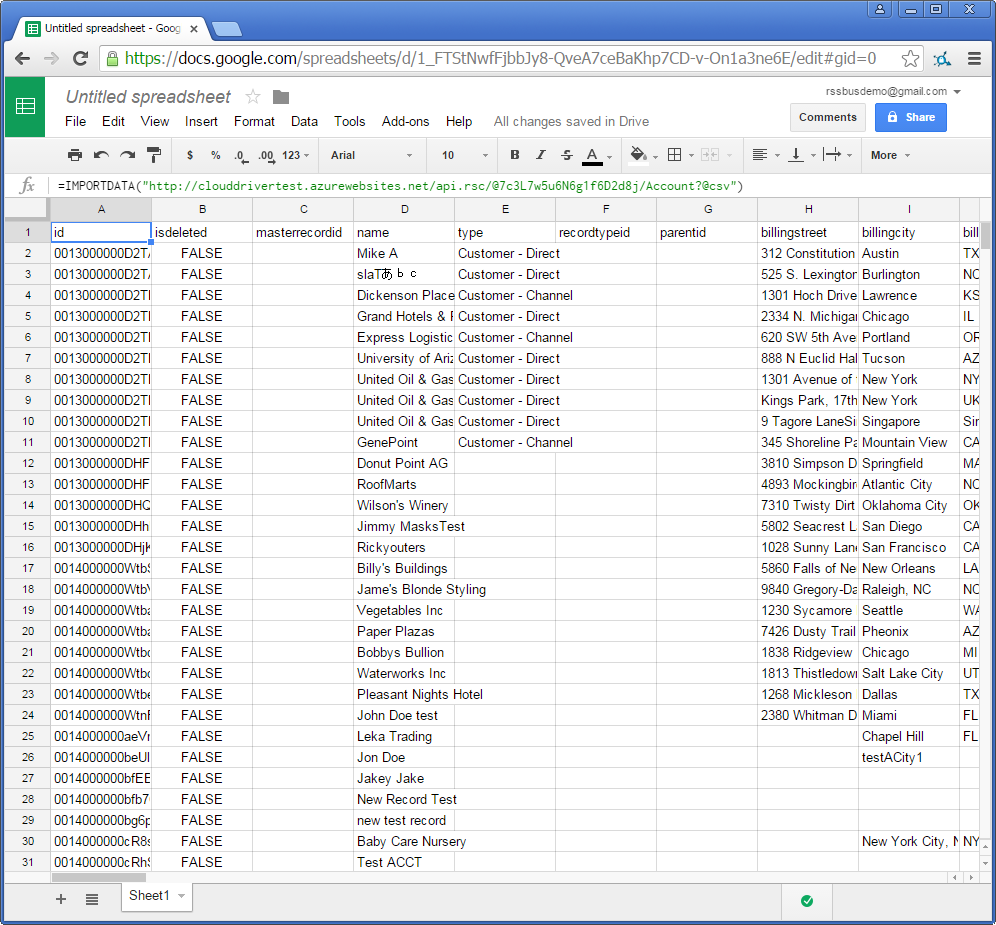Model Context Protocol (MCP) finally gives AI models a way to access the business data needed to make them really useful at work. CData MCP Servers have the depth and performance to make sure AI has access to all of the answers.
Try them now for free →How to Import Data from MongoDB into Google Sheets
Import MongoDB data into a Google spreadsheet that is automatically refreshed.
The CData API Server, when paired with the ADO.NET Provider for MongoDB (or any of 200+ other ADO.NET Providers), connects cloud applications, mobile devices, and other online applications to MongoDB data via Web services, the standards that enable real-time access to external data. Use Google Sheets' built-in support for Web services to rely on up-to-date MongoDB data, automate manual processes like rekeying data, and avoid uploading files.
What is The API Server?
The API Server is a lightweight Web application that runs on your server and produces secure feeds of any of 200+ data sources. The .NET edition can be deployed to Azure in 3 steps. The Java edition can be deployed to Heroku as well as any Java servlet container. You can also easily deploy on an Amazon EC2 AMI.
About MongoDB Data Integration
Accessing and integrating live data from MongoDB has never been easier with CData. Customers rely on CData connectivity to:
- Access data from MongoDB 2.6 and above, ensuring broad usability across various MongoDB versions.
- Easily manage unstructured data thanks to flexible NoSQL (learn more here: Leading-Edge Drivers for NoSQL Integration).
- Leverage feature advantages over other NoSQL drivers and realize functional benefits when working with MongoDB data (learn more here: A Feature Comparison of Drivers for NoSQL).
MongoDB's flexibility means that it can be used as a transactional, operational, or analytical database. That means CData customers use our solutions to integrate their business data with MongoDB or integrate their MongoDB data with their data warehouse (or both). Customers also leverage our live connectivity options to analyze and report on MongoDB directly from their preferred tools, like Power BI and Tableau.
For more details on MongoDB use case and how CData enhances your MongoDB experience, check out our blog post: The Top 10 Real-World MongoDB Use Cases You Should Know in 2024.
Getting Started
Why Web Services?
Google Sheets is one of the easiest ways to collaborate in real time, so it should be easy to collaboratively work with MongoDB data and your other data sources in Google Sheets. However, it can be difficult to get data into Google Sheets. Often, a manual process is required, such as rekeying data or uploading CSV files. Working with a copy rather than the external data, the spreadsheet quickly becomes out of date.
The API Server provides an alternative to physically transferring data into and out of Google Sheets. The API Server provides native read/write connectivity to external MongoDB data from both built-in formulas and Google Apps Script.
Instead of manually copying your data, formatting it, and uploading a spreadsheet, retrieving MongoDB data into Google Sheets is as simple as using the ImportData formula to make calls to the API Server. The API Server exposes the capabilities of the MongoDB API as standard OData queries. The sheet will automatically retrieve updates by periodically executing the query. Below is an example of a search.
https://MyServer:MyPort/api.rsc/restaurants/?filter=Name eq 'Morris Park Bake Shop'
See the API page in the API Server administration console for more information on the supported OData.
Are Web Services Secure?
The CData API Server, when paired with any of 200+ other ADO.NET Providers, helps you control access to your data. Unlike data integration services hosted in the cloud, the API Server runs on servers you control; it can run inside or outside the firewall.
You can also use the API Server to take advantage of standard technology for protecting the confidentiality, authenticity, and intended recipients of your data. The API Server supports TLS/SSL and the major forms of authentication. The .NET edition supports standard ASP.NET security. The Java edition is integrated with J2EE security.
How to Retrieve External MongoDB Data in Google Sheets
You can consume MongoDB data in Google Sheets in 3 steps:
If you have not already connected successfully in the API Server administration console, see the "Getting Started" chapter in the help documentation for a guide.
Authenticate your query with the authtoken of a user authorized to access the OData endpoint of the API Server. The API Server also restricts access based on IP address; you will need to enable access from Google's servers. You can configure access controls on the Security tab.
The ImportData function takes one parameter, the URL, so authentication must be supplied in the URL. For security reasons, the API Server does not allow setting the authtoken in the URL by default, so you will need to enable this by adding the following in settings.cfg. If you would like to use another authentication scheme, like HTTP Basic, see the MongoDB and Google Apps Script how-to.
[Application] AllowAuthTokenInUrl = trueThe settings.cfg file is located in the data directory. In the .NET edition, the data directory is the app_data folder under the www folder. In the Java edition, the data directory's location depends on the operation system:
- Windows: C:\ProgramData\CData\MongoDB\
- Unix or Mac OS X: ~/cdata/MongoDB/
In a new Google sheet, use the ImportData formula to request the CSV file from the OData endpoint of the API Server. Specify the format of the response with the @csv query string parameter. Google will periodically update the results of the formula, ensuring that the sheet contains up-to-date data. You can request the entire restaurants table with a formula like the one below:
=ImportData("https://your-server/api.rsc/restaurants?@csv&@authtoken=your-authtoken")

